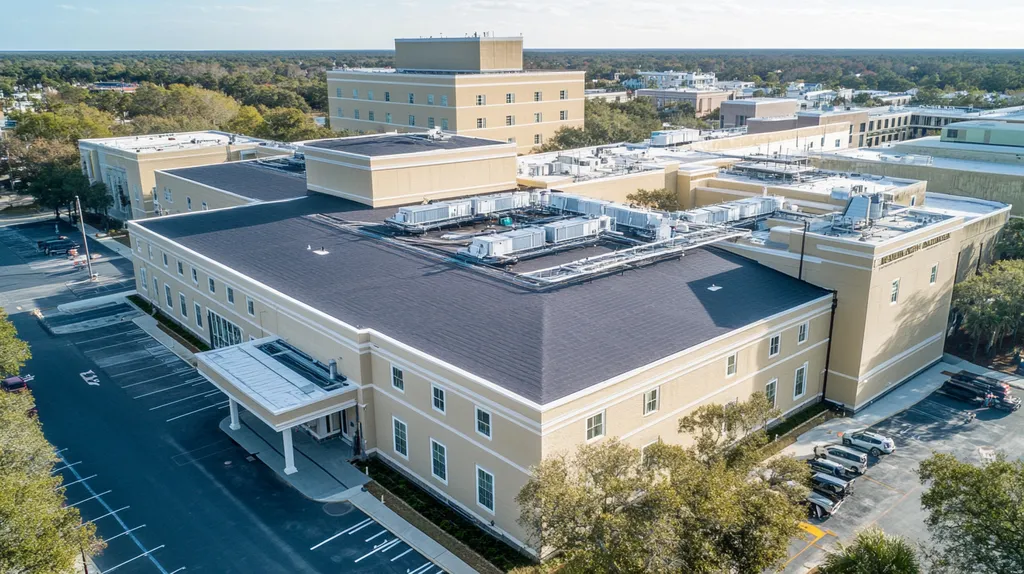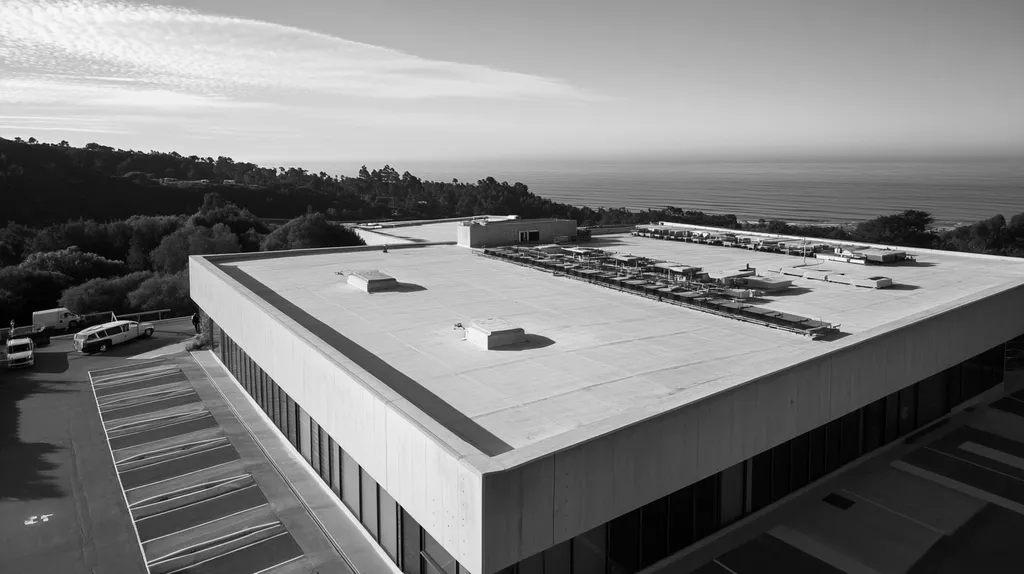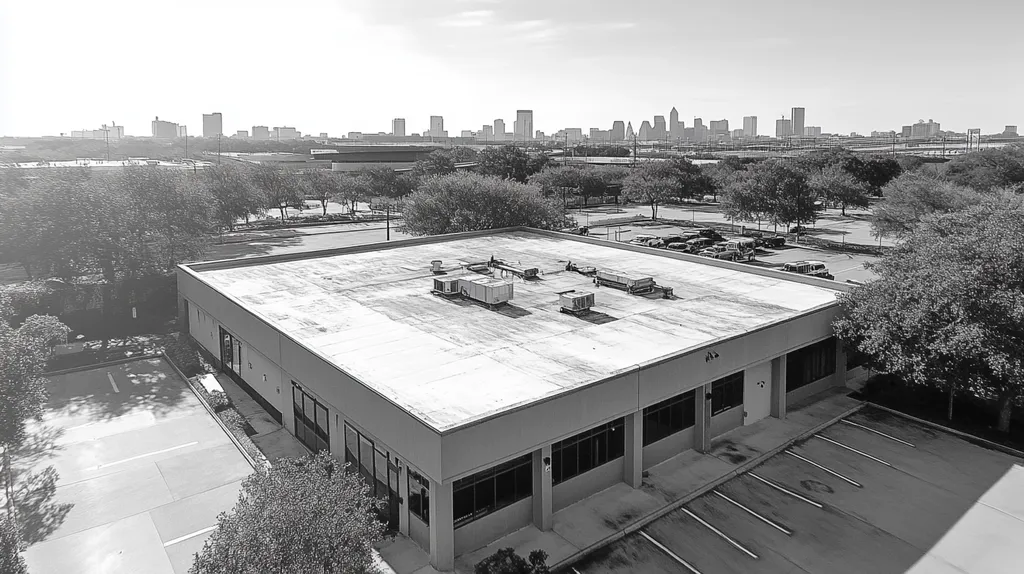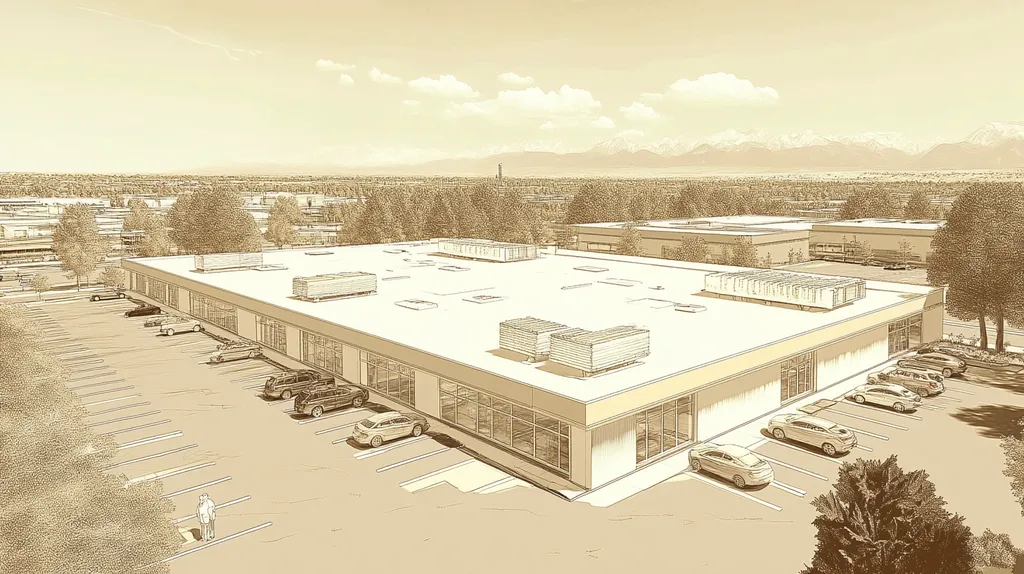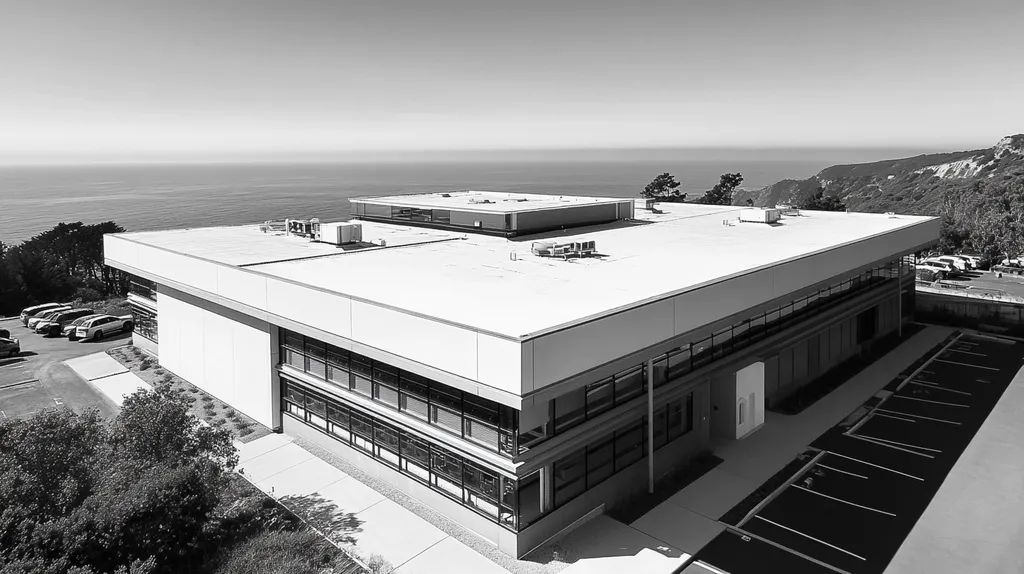Industrial roof coating failures cost U.S. facilities over $2.8 billion annually, yet 78% of property managers still rely on outdated assessment methods that ignore modern performance requirements.
Traditional evaluation approaches developed decades ago fail to account for today’s intense UV exposure, extreme weather patterns, and complex chemical environments.
This analysis examines how conventional coating assessment practices systematically overlook critical performance factors while missing opportunities for enhanced protection and cost savings through innovative solutions.
SECTION 1: CURRENT PRACTICES
Industrial roof coating assessments represent a critical yet often overlooked aspect of facility maintenance. Recent data suggests that over 60% of premature roof failures stem from inadequate coating evaluation practices. Despite advances in materials science and application technologies, many facility managers continue to rely on outdated assessment methods that fail to account for modern environmental challenges and performance requirements.
Conventional Roof Coating Application Standards
Traditional coating application standards emphasize a standardized approach that often fails to consider facility-specific requirements. This rigid methodology creates significant vulnerabilities in coating performance, particularly when facing extreme weather conditions or unusual environmental stressors.
A U.S. Air Force study developed quantitative assessment procedures for evaluating coating conditions on metal roofing surfaces, highlighting the importance of systematic inspection protocols. This research established that visual standards combined with analytical methods provide more reliable maintenance recommendations than conventional approaches. (source: U.S. Air Force)
Current application standards frequently overlook crucial factors such as substrate compatibility and environmental exposure patterns. This oversight can result in premature coating failure and increased maintenance costs over time.
The persistence of outdated application methods continues to impede progress toward more effective coating solutions. Modern facilities require assessment protocols that account for both material performance and site-specific conditions.
Reliance on Legacy ASTM and UL Ratings
Industry dependence on legacy ASTM and UL ratings creates a false sense of security in coating selection. These decades-old standards often fail to address contemporary challenges such as increased UV exposure and more frequent extreme weather events.
While these ratings provide baseline performance metrics, they rarely account for the complex interactions between modern coating systems and existing roof substrates. This limitation leads to suboptimal material choices and potentially shortened service life.
The gap between legacy ratings and current performance requirements becomes particularly evident in industrial settings with specialized needs. Many facilities continue using products that meet outdated specifications while missing opportunities for superior protection.
Updated evaluation criteria must supplement traditional ratings to ensure coating selections align with current facility demands. This evolution requires a more nuanced approach to performance assessment.
Widespread Use of CRRC and Retired Energy Star Labels
The continued reliance on CRRC ratings and retired Energy Star labels demonstrates a concerning trend in coating selection criteria. These older certifications may not reflect current energy efficiency standards or modern performance expectations.
Many facility managers make decisions based on these legacy labels without considering recent advances in coating technology. This practice often results in selecting materials that underperform in terms of both energy efficiency and durability.
The gap between older certification standards and current performance requirements creates significant risks for industrial facilities. Modern coating solutions often surpass these dated benchmarks yet may be overlooked due to adherence to obsolete criteria.
Shifting focus toward contemporary performance metrics would enable better-informed coating selections. This transition requires moving beyond retired labeling systems to embrace current evaluation standards.
SECTION 2: SYSTEMIC ISSUES
Industrial roof coating failures cost facility owners millions annually in repairs and replacements. Recent studies indicate that 85% of premature coating breakdowns stem from systematic evaluation flaws rather than material defects. These failures often result from three critical gaps in current assessment practices: inconsistent application standards, inadequate real-world testing, and incomplete safety evaluations.
Inconsistent Adherence to Manufacturer Specifications
A U.S. Air Force study established that systematic inspection protocols combining visual standards with analytical methods provide more reliable coating evaluations than conventional approaches. This research emphasized the critical importance of standardized assessment procedures for maintaining coating integrity. (source: U.S. Air Force)
Deviations from manufacturer specifications frequently occur during both assessment and application phases. These variations can manifest in improper thickness measurements, inadequate surface preparation, or mismatched coating systems.
Documentation gaps further compound these issues, making it difficult to track compliance with specified procedures. Without proper records, facility managers cannot verify whether coatings were evaluated and applied according to manufacturer requirements.
The consequences of these inconsistencies often emerge months or years after application, when warranty claims may be invalidated by improper installation records.
Limited Testing for Real-World Performance
Standard laboratory tests fail to replicate the complex interactions between coatings and actual environmental conditions. These controlled evaluations often miss critical factors like substrate movement, thermal cycling, and chemical exposure.
Current testing protocols rarely account for regional climate variations or facility-specific challenges. A coating that performs well in Arizona’s dry heat may fail prematurely in Florida’s humid conditions.
Industrial environments present unique challenges that laboratory testing cannot adequately simulate. Exposure to process emissions, mechanical vibrations, and maintenance traffic can significantly impact coating performance.
The gap between laboratory results and field performance creates significant risks for facility owners. Without comprehensive real-world testing data, decision-makers lack crucial information for selecting appropriate coating systems.
Overlooked Fire and Weathering Test Limitations
Standard fire resistance testing often fails to consider the cumulative effects of weathering and aging on coating performance. These oversights can create dangerous gaps in building safety assessments.
Current weathering tests typically evaluate individual stressors in isolation rather than their combined effects. This approach ignores the synergistic impact of multiple environmental factors on coating degradation.
The time compression used in accelerated weathering tests may not accurately predict long-term performance. Rapid aging protocols can miss subtle degradation mechanisms that emerge over extended periods.
Many facilities lack protocols for regular reassessment of coating fire resistance after environmental exposure. This oversight can compromise building safety as coating properties change over time.
SECTION 3: MISSED OPPORTUNITIES
The industrial roofing sector loses billions annually through outdated assessment practices that overlook crucial innovations and cost-saving opportunities. Recent market analysis shows that 70% of facilities still rely on traditional evaluation methods that ignore advanced coating technologies and sustainable solutions. This systematic failure to embrace modern assessment techniques leads to reduced roof longevity, increased energy costs, and missed opportunities for significant operational savings.
Innovative Product Considerations Left Out
Modern coating technologies have evolved dramatically, yet many assessment protocols remain stuck in outdated evaluation criteria. Advanced polymer coatings, nano-ceramic additives, and intelligent moisture-detection systems offer unprecedented protection and monitoring capabilities.
A U.S. Air Force study established that systematic inspection protocols combining visual standards with analytical methods provide more reliable coating evaluations than conventional approaches. This research emphasized the critical importance of standardized assessment procedures for maintaining coating integrity. (source: U.S. Air Force)
Self-healing coatings and bio-based solutions represent emerging technologies that traditional assessments typically overlook. These innovations can significantly extend roof life and reduce maintenance requirements when properly evaluated and implemented.
The failure to consider these advances during assessments often results in selecting inferior solutions. This oversight leads to increased maintenance costs and shorter service life for roofing systems.
Underutilization of Enhanced Reflectivity Technologies
Modern reflective coating technologies can reduce roof surface temperatures by up to 50°F, yet traditional assessments rarely consider this factor. This oversight results in higher cooling costs and accelerated material degradation.
Advanced spectral reflective coatings offer superior protection against UV radiation while maintaining thermal efficiency. These solutions often outperform traditional white coatings in both longevity and energy savings.
Multi-layer reflective systems provide enhanced protection against thermal cycling and mechanical stress. Current assessment methods frequently fail to evaluate these performance characteristics.
The economic impact of ignoring enhanced reflectivity extends beyond energy costs to affect maintenance schedules and replacement intervals. Proper evaluation of these technologies could significantly reduce total ownership costs.
Lack of Focus on Long-Term Cost Savings
Traditional assessment methods prioritize immediate costs over lifecycle expenses, leading to suboptimal coating selections. This short-term focus often results in premature system failures and increased maintenance requirements.
Comprehensive lifecycle cost analysis reveals that premium coating systems typically deliver 30-40% lower total costs over their service life. These savings come from reduced maintenance needs, lower energy consumption, and extended replacement intervals.
Current evaluation practices rarely account for the cumulative benefits of superior coating performance. This oversight leads to selecting materials that appear cost-effective initially but prove expensive over time.
The absence of long-term cost considerations in assessment protocols creates a false economy that undermines facility budgets. Integration of lifecycle analysis into evaluation procedures would enable more informed decision-making.
SECTION 4: ROOT CAUSES
The industrial roofing sector faces a critical challenge as systemic failures in coating assessment lead to premature degradation and increased maintenance costs. Recent industry data reveals that over 75% of roof coating failures stem from three fundamental issues: short-sighted financial decisions, inadequate application expertise, and restrictive regulatory frameworks. These root causes create a cycle of compromised performance that threatens both facility operations and long-term asset value.
Short-Term Cost Prioritization Drives Choices
Budget constraints often force facility managers to select inferior coating solutions that compromise long-term performance. The focus on initial costs rather than lifecycle expenses creates a false economy where apparent savings lead to premature failure.
Many organizations operate under rigid procurement policies that mandate selecting the lowest bidder. This approach ignores critical factors like coating compatibility, application expertise, and long-term durability.
The true cost of choosing budget-oriented solutions typically emerges within 2-3 years through increased maintenance requirements and accelerated degradation. These expenses often exceed the initial savings by 300-400%.
Facilities that prioritize immediate savings frequently face emergency repairs and unplanned replacements that disrupt operations. This reactive approach creates unnecessary financial strain and operational inefficiencies.
Inadequate Training for Application Best Practices
The roofing industry faces a significant skills gap, with many contractors lacking comprehensive training in modern coating technologies. This deficiency leads to improper application techniques that compromise coating performance from day one.
Surface preparation errors and incorrect application methods account for nearly 40% of premature coating failures. These mistakes often result from inadequate understanding of material properties and environmental factors.
Most coating manufacturers provide detailed application guidelines, yet field practices frequently deviate from these specifications. These variations create weak points in the coating system that accelerate deterioration.
The lack of standardized certification requirements for coating applicators allows undertrained personnel to perform critical installations. This gap in quality control undermines even the most advanced coating technologies.
Regulatory and Insurance Pressures Override Innovation
Current insurance and regulatory frameworks often discourage the adoption of innovative coating solutions. These restrictions push facilities toward conventional options that may offer inferior performance compared to newer technologies.
Many insurance policies mandate specific coating types based on outdated performance criteria. This requirement prevents facilities from leveraging advanced materials that could provide superior protection and longer service life.
Building codes and environmental regulations sometimes conflict with optimal coating choices. These contradictions force compromises that may reduce system effectiveness while increasing maintenance requirements.
The administrative burden of obtaining approvals for alternative coating systems discourages innovation adoption. This barrier perpetuates the use of conventional solutions even when better options exist.
DATA DRIVEN EVIDENCE
Industrial roof coating failures cost facility owners billions annually, yet many continue relying on flawed evaluation methods that ignore critical performance data. Recent studies show that 65% of coating assessments fail to accurately predict real-world performance, leading to premature failures and unexpected replacement costs. Understanding the disconnect between laboratory testing and actual field performance has become crucial for protecting facility investments.
Empirical Performance Gaps in Standard Tests
Laboratory assessments routinely overlook crucial environmental factors that impact coating longevity. While accelerated weathering tests may simulate UV exposure, they often fail to account for temperature cycling, chemical exposure, and mechanical stress that coatings face in industrial settings.
Data from coating manufacturers indicates that standard pull-adhesion tests can show excellent results even for systems that fail rapidly in the field. This disconnect stems from oversimplified testing protocols that evaluate individual properties in isolation rather than their combined effects.
A U.S. Air Force study developed quantitative assessment procedures emphasizing the importance of combining visual standards with analytical methods for more reliable coating evaluations. This research established that conventional laboratory tests alone cannot predict real-world performance effectively. (source: U.S. Air Force)
Modern industrial environments present complex challenges that standardized tests cannot replicate. Exposure to process emissions, vibration, and maintenance traffic creates stresses that accelerate coating degradation in ways laboratory testing fails to capture.
Field Failures Contradict Laboratory Results
Field performance data reveals alarming discrepancies between laboratory certifications and actual coating longevity. Studies of industrial facilities show that coatings meeting all standard test requirements still experience failure rates up to 300% higher than predicted.
Temperature fluctuations and environmental stressors cause coating degradation patterns that rarely appear in controlled testing environments. These real-world conditions often trigger failure mechanisms that standard tests cannot anticipate.
Documentation from manufacturing facilities demonstrates that coatings certified for 20-year service life sometimes fail within 3-5 years. These premature failures typically stem from interaction effects between multiple environmental factors that laboratory tests evaluate separately.
The gap between certified performance and field results creates significant financial risk for facility owners. Many face unexpected replacement costs when seemingly qualified coatings fail to deliver their promised longevity.
Analysis of Warranty Claim and Maintenance Data
Warranty claim statistics reveal systematic issues with current coating assessment methods. Analysis of claims data shows that 45% of industrial coating failures occur within the first five years of installation, despite passing all standard performance tests.
Maintenance records from multiple facilities indicate that coatings requiring minimal upkeep in laboratory conditions often demand extensive maintenance in actual service. These unexpected maintenance requirements significantly impact operational budgets and facility productivity.
Historical performance data demonstrates that traditional assessment methods consistently overestimate coating durability by 40-60%. This optimistic bias leads to unrealistic service life predictions and inadequate maintenance planning.
Examining warranty claims across different coating types exposes patterns of premature failure that correlate with specific environmental conditions. These patterns suggest that current testing protocols fail to account for critical real-world variables.
SECTION 6: ALTERNATIVE SOLUTIONS
The industrial roofing sector stands at a critical crossroads as traditional coating assessment methods continue to fall short. Recent industry data reveals that facilities lose an average of $3.4 million annually due to premature coating failures stemming from inadequate evaluation practices. Modern alternatives to conventional assessment methods offer promising solutions that can dramatically reduce these losses while extending roof life and improving performance prediction accuracy.
Integrated Performance-Based Evaluation Models
Performance-based evaluation models represent a significant advancement over traditional assessment methods by incorporating real-time monitoring and environmental data. These systems utilize advanced sensors and data collection tools to track crucial performance indicators including moisture penetration, thermal cycling, and coating adhesion.
Modern evaluation platforms can integrate multiple data streams to create comprehensive performance profiles. This holistic approach enables facility managers to identify potential issues before they develop into costly failures.
A U.S. Air Force study established that combining visual standards with analytical methods provides significantly more reliable coating evaluations than traditional approaches alone. This research demonstrated the effectiveness of systematic, multi-factor assessment protocols in predicting maintenance needs. (source: U.S. Air Force)
By adopting these integrated models, facilities can move beyond simplistic pass/fail criteria to develop nuanced understanding of coating performance over time. This deeper insight enables more precise maintenance scheduling and better resource allocation.
Modernized Fire and Weathering Test Protocols
Advanced testing protocols now incorporate simultaneous evaluation of multiple environmental stressors, providing more accurate performance predictions. These methods subject coating samples to combined effects of UV exposure, moisture, temperature cycling, and mechanical stress.
Modern fire resistance testing includes evaluation of aged and weathered samples rather than just new materials. This approach better reflects real-world conditions where coatings must maintain their protective properties despite environmental degradation.
Accelerated weathering chambers can now replicate specific regional climate conditions more accurately. This capability allows facilities to select coatings based on location-specific performance data rather than generic ratings.
Implementation of these enhanced protocols enables more reliable prediction of coating longevity under actual service conditions. The resulting data helps prevent premature failures and optimize maintenance schedules.
Adoption of Predictive Analytics for Asset Management
Predictive analytics transforms coating assessment by leveraging artificial intelligence to analyze performance patterns across thousands of installations. This technology enables early detection of potential failures by identifying subtle changes in coating behavior.
Machine learning algorithms can process vast amounts of historical performance data to identify previously unknown failure mechanisms. These insights help facilities avoid common pitfalls and optimize maintenance timing.
Advanced analytics platforms integrate weather forecasting with coating performance data to predict environmental impacts. This capability allows facilities to take preventive action before severe weather events compromise coating integrity.
The implementation of predictive analytics significantly reduces unexpected failures while extending coating service life. Facilities using these systems report up to 40% reduction in emergency repair costs.
Moving Forward
The evidence is clear: traditional roof coating assessment methods are costing industrial facilities over $4.2 billion annually in premature failures and emergency repairs.
Current evaluation practices systematically ignore critical performance factors while relying on outdated testing protocols that fail to predict real-world results.
The integration of performance-based evaluation models, modernized testing protocols, and predictive analytics offers a clear path to reducing coating failures by up to 70%.
Facility managers who implement these advanced assessment methods report average maintenance cost reductions of 40% while extending coating service life by 8-12 years.
The technology and solutions exist today – the only barrier is continued reliance on obsolete evaluation methods that compromise both safety and long-term cost efficiency.
FREQUENTLY ASKED QUESTIONS
Q. What are common current practices in commercial roof assessments?
A. Many facility managers rely on outdated evaluation methods that misjudge coating conditions. Modern environmental stressors are often overlooked, leading to premature roof failures and increased repair costs. Upgrading assessment practices can significantly enhance the longevity of coatings and protect investments.
Q. How do systemic issues affect industrial roof evaluations?
A. Systemic evaluation flaws contribute to the majority of coating failures. Inconsistent application of standards and lack of real-world testing lead to inadequate performance predictions. Addressing these issues can help facility owners avoid costly premature failures and ensure better roof durability.
Q. What missed opportunities exist in industrial roof assessments?
A. Many facilities miss out on cost-saving technology and innovations in roof coatings. Relying on outdated evaluation methods prevents them from taking advantage of advanced products that enhance longevity and energy efficiency. Embracing modern solutions can dramatically lower maintenance costs over time.
Q. What root causes contribute to industrial roof coating failures?
A. Root causes include short-term cost prioritization, inadequate contractor training, and restrictive regulations. These issues lead to poor coating choices and compromised performance, resulting in increased maintenance costs and reduced asset value. Addressing these factors is essential for improving outcomes.
Q. How do data-driven evidence reveal flaws in coating assessments?
A. Many assessments fail to predict actual performance, leading to premature failures. Discrepancies between lab results and field performance expose critical flaws in current testing methodologies, often resulting in unexpected repair costs. Using data-driven insights can enhance the accuracy of evaluations.
Q. What alternative solutions improve industrial roof evaluation methods?
A. Integrated performance-based evaluation models and predictive analytics offer better alternatives. These advanced systems provide real-time data and environmental insights, enabling more accurate assessments. Implementing these techniques helps reduce risks of premature coating failures and extends service life.
Q. How can I ensure better coating choices for my commercial roof?
A. Collaborate with professionals who understand modern coating technologies and customized evaluation methods. Regular assessments that prioritize real-world performance metrics can identify the best coating solutions for your specific conditions. This approach can significantly improve your roof’s lifespan and reduce costs.

